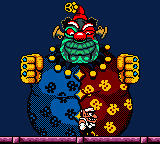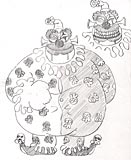Rudy
- Not to be confused with Ruby.
Template:Character-infobox Template:Quote2
Rudy, originally known as "A hidden figure", is one of Wario's enemies, appearing as the main villain of both Wario Land 3 and Dr. Mario 64. Rudy is a giant clown-like creature with green skin, a big red nose, and detached floating hands by his sides, although concept art of him as the final boss of Wario Land 3 depicted him with regular arms. He is only referred to as "a hidden figure" in Wario Land 3, only later being given the name "Rudy" in the English version of Dr. Mario 64, and later being referred to by Wario as "Rudy the Clown" in Fortune Street. In Japanese versions, however, Rudy is never called a specific name, even in the Dr. Mario 64 port of Nintendo Puzzle Collection.[1]
History
Wario Land 3
When Wario was trapped in the world inside a music box in Wario Land 3, a hidden figure appeared as a giant shadowy face in a temple, pleading Wario's help. He states that he is the god of this world, and an evil being sealed away his powers in five music boxes. He requests Wario to break the seal by bringing all five music boxes to him. Wario is unwilling to help at first, until he mentions that he will send Wario home when he is freed and will let Wario keep any treasures he finds along the way. After that, Wario sets out to collect the music boxes.
During the course of the game, Wario can visit the hidden figure at The Temple and be instructed in which level he has to go next in order to progress.
Eventually, Wario collects all the music boxes, and frees him. A hidden figure then turns into his true form, a giant clown whereupon he says that he will take over the music box's world as well as the outer world. It is later revealed that he turned all the world's inhabitants into the monsters that Wario defeated during his quest; he was using Wario to break the curse placed on him by the inhabitants of the world of the music box when he had tried to take control before.
He attacks Wario with his hands, attempting to grab or smash Wario. He is very powerful, and if he successfully grabs Wario, the player instantly gets a Game Over, the only attack in the game to do so. However, Wario must avoid his hands and attack them, leaving them stunned on the floor. After that, Wario has to grab the hands, and throw them at his face. After four hits, he is defeated and the inhabitants of the music box world are returned to normal. They then send Wario back to his own world, letting him keep all the treasure he had found.
Dr. Mario 64
The character returns as the main antagonist in Dr. Mario 64, now officially named as Rudy. He sends his minion Mad Scienstein to steal some Megavitamins from Dr. Mario, planning to use them to cure his cold. Mad Scienstein steals the Megavitamins, but is followed by Dr. Mario and Wario, the latter of whom wanted the Megavitamins for himself. The duo eventually came to Rudy's castle and defeat Rudy, taking back the Megavitamins and curing his cold as well.
Fortune Street
Though he does not physically appear, Rudy is referenced in Fortune Street. When Wario builds a circus tent on the game board, he states "This is gonna be the best circus ever... as long as Rudy the Clown doesn't show up!"
Names in other languages
| Language | Name | Meaning | Notes |
|---|---|---|---|
| Japanese | ナゾのぞう[?] Nazo no Zō |
A Mysterious Figure | |
| Chinese | 神秘像[?] shén mì xìang |
Mysterious Figure | |
| Spanish | Payaso[2] | Clown |
Trivia
- In his concept artwork, Rudy has arms. However, in the game, his hands are separate, floating graphics, stated to be due to hardware limitations, as the amount of graphics the arms would require would not be manageable.[3]
- In Wario Land 3 coverage, Nintendo Power describes the hidden figure as a "mysterious monarch".[4]
References
- ^ "Dr. Mario 64: From English to Japanese". The Mushroom Kingdom.
- ^ Official Wario Land 3 website (Guías Nintendo)
- ^ Nintendo online magazine
- ^ Nintendo Power Volume 133, page 58.
| Dr. Mario 64 | |
|---|---|
| Playable characters | Dr. Mario • Wario • Spearhead • Webber • Silky • Appleby • Jellybob • Octo • Helio • Lump • Hammer-Bot • Mad Scienstein • Rudy • Metal Mario • Vampire Wario |
| Other characters | Para-Goom • Virus |
| Items and objects | Vitamin Capsule |
| Themes | Chill • Fever |
| Other | Gallery • Staff |

